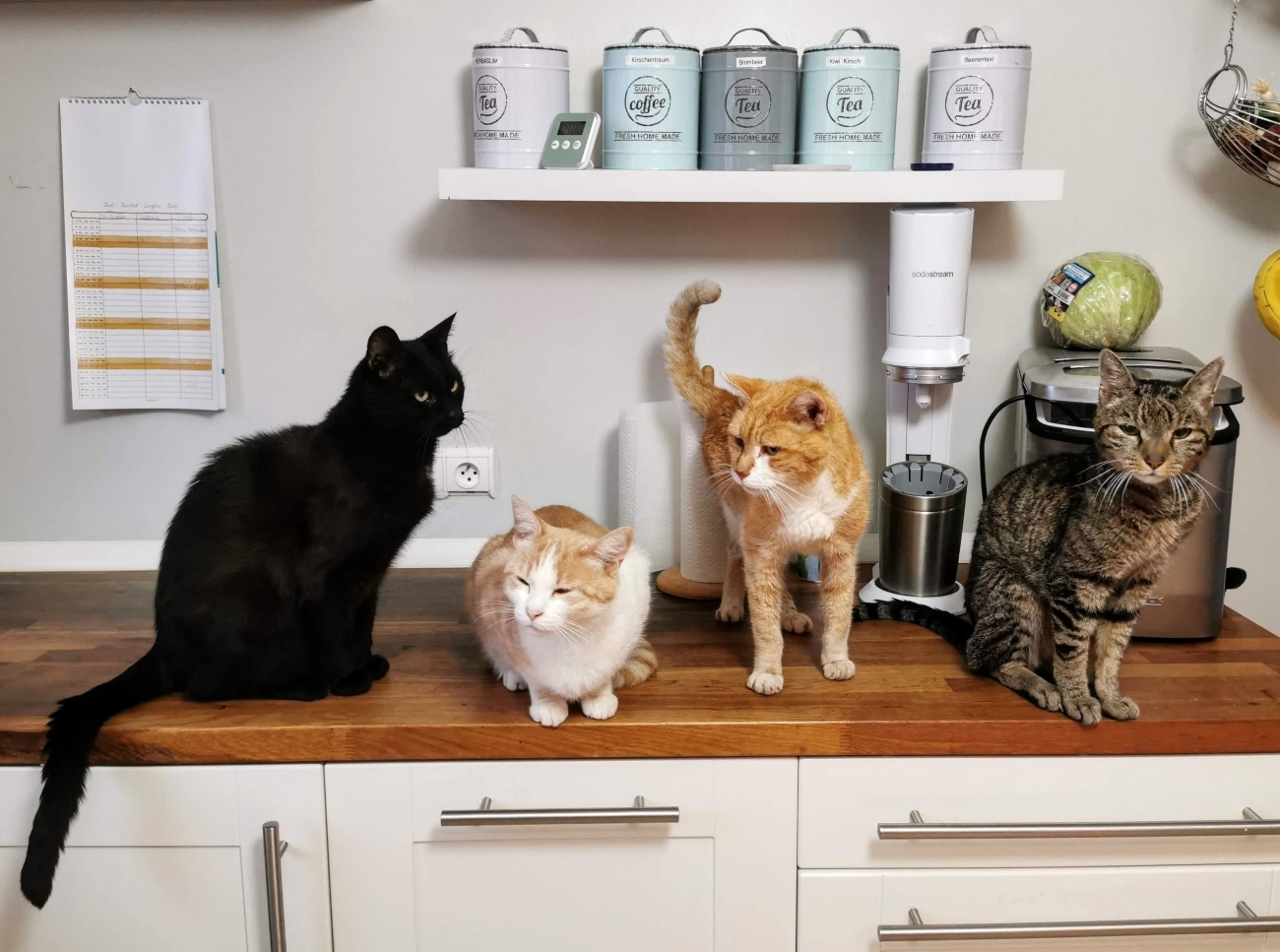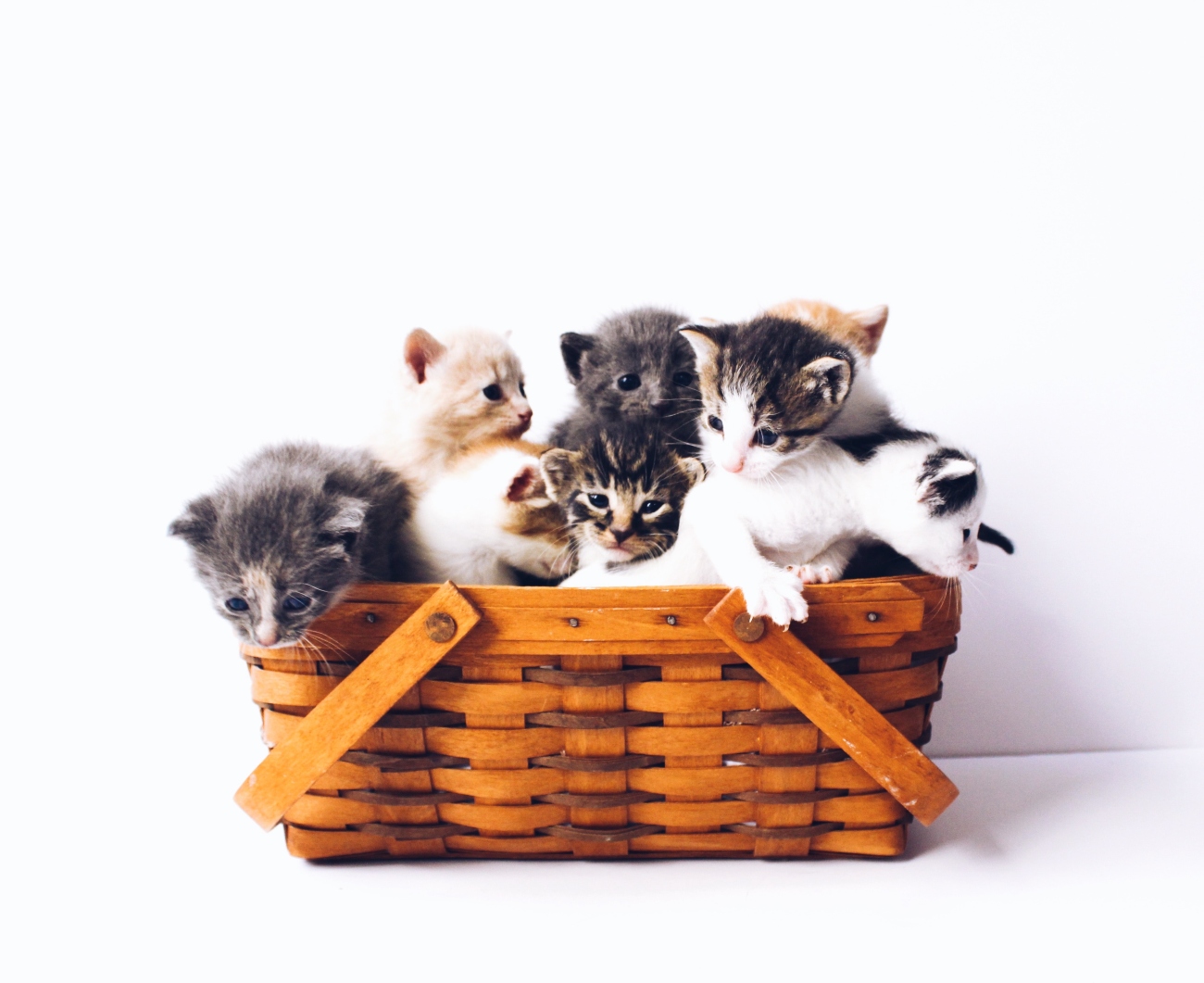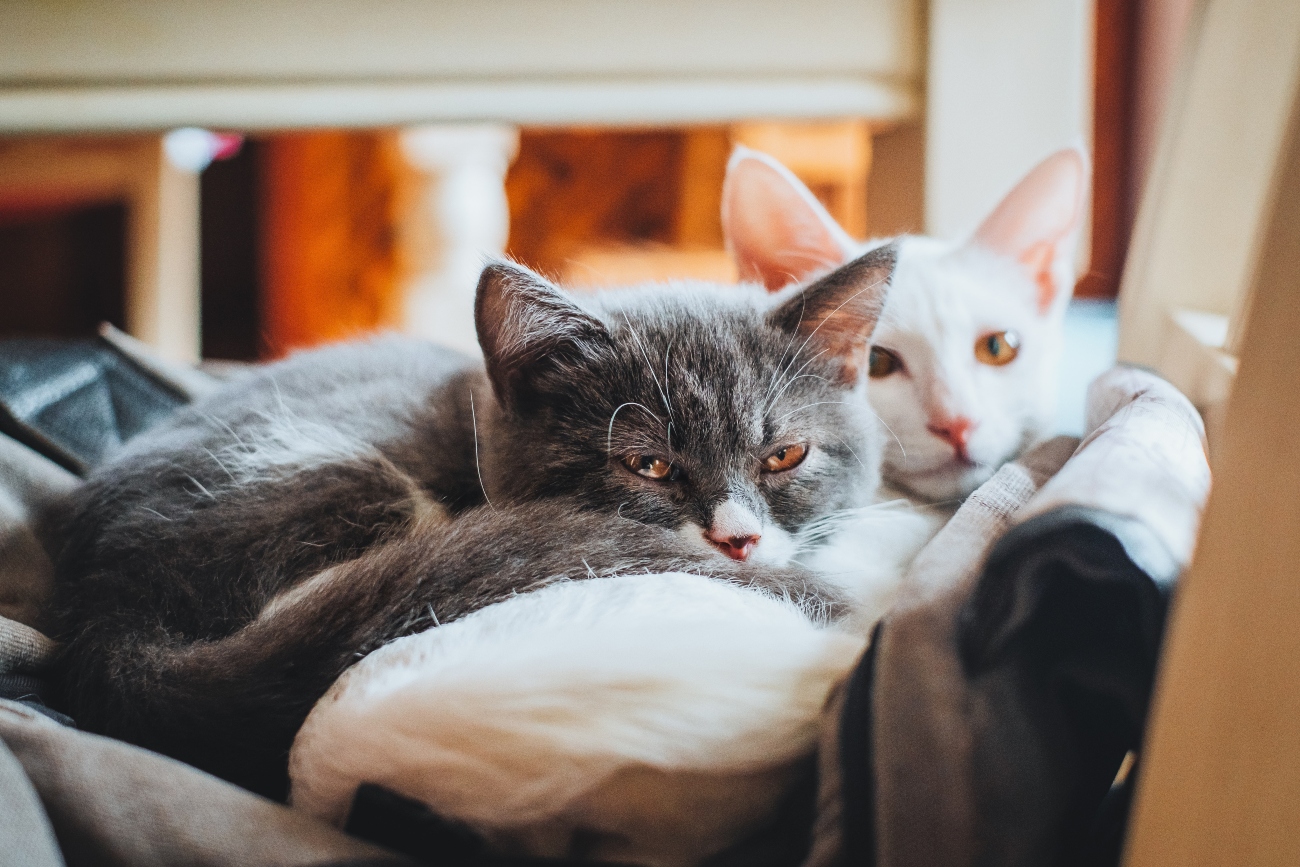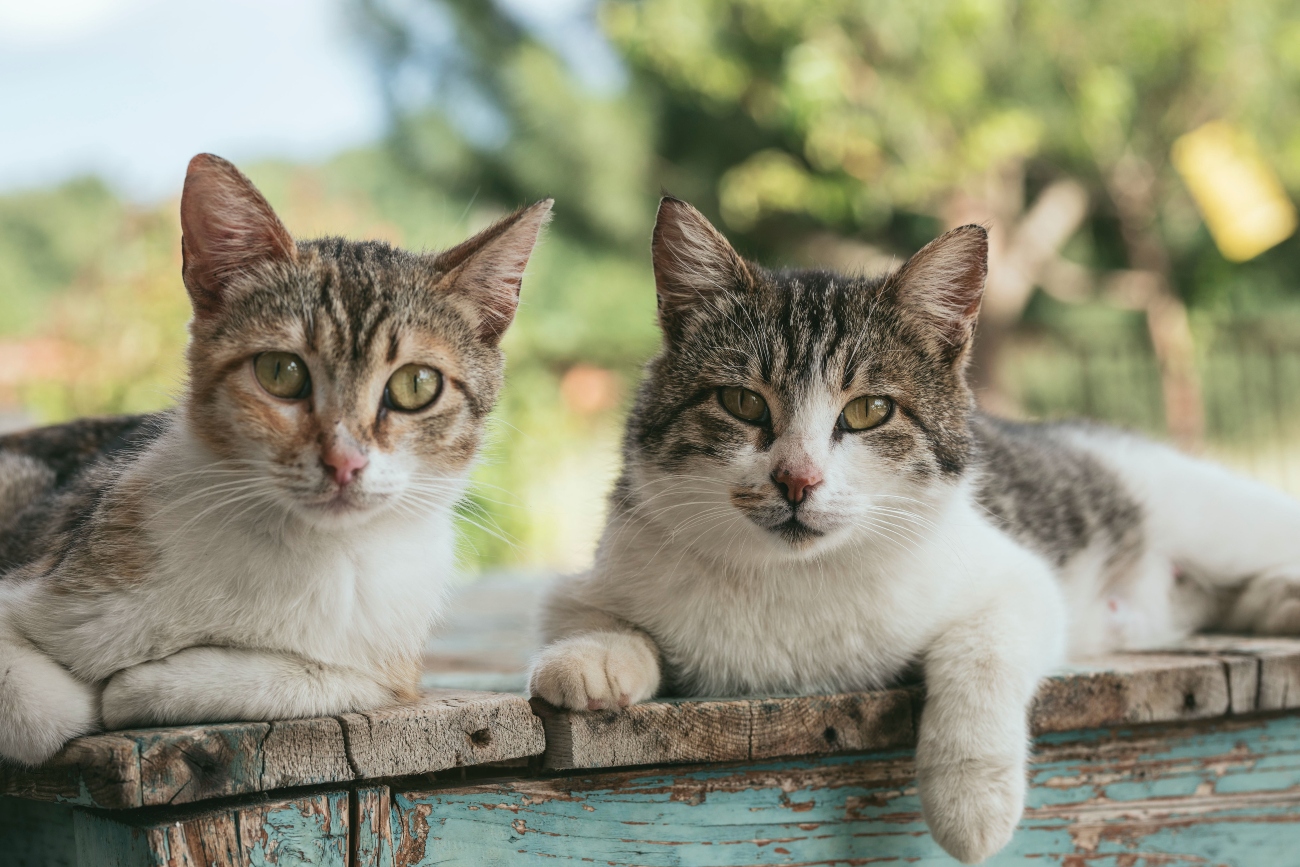
Top tips for living in a multi-cat household
24th February, 2022
Cats bring their owners such pleasure, it’s no wonder that many of us think about whether bringing another cat or two into the household might be a good idea. Being a multi-cat household can work out, but there is also a risk of conflict between your pets.
Let’s look at the key issues involved in creating a multi-cat household and how pet insurance for older cats could help you protect the older members of your feline family.
Why would you want more than one cat?
It’s obvious why you might want more than one cat: more love! However, there are certain situations where you might be tempted to bring another cat into your home. For example, you might be going to get a new kitten - should you get two instead, to keep each other company?
You might have a needy cat that won’t leave you alone. Would another cat provide her with the company she needs? Alternatively, you may have an older cat and you think it would give her a new lease of life to have a young cat to take under her wing.
Maybe your cat has had a litter and you have fallen in love with the kittens – should you keep one for yourself? Another common scenario is when a cat practically falls into your lap – a stray might adopt you, or a friend or relative might not be able to care for their old pet any longer and asks you to take it in.

What can go wrong?
If cats do not get on with one another, your household can quickly become a stressful and unpleasant place to be. In a worst case scenario, one cat might decide to run away and seek a new home, or your pets might get in a fight and injure one another.
It’s worth remembering that today’s domestic cats have common ancestry with African wildcats. They are descended from animals that would have lived like African wildcats today - they are solitary creatures that live in the savannah. These wildcats have rodents as a main food source, but the rodents are spread sparsely across large areas. This means each cat needs to have its own patch of territory in order to find enough to eat.
Where cats do live in a group, for example a feral colony, they only accept each other if they have enough food for everyone and perceive the others to be part of the same social group. Colonies are made up of female cats who groom each other and rub against each other to ensure they share a common scent. A cat with a different scent will not be accepted by the group.
It is worth bearing in mind these natural behaviours when thinking about forming a multi-cat household. Key points are that cats need to share a scent in order to accept each other, and competition for food is likely to lead to conflict. Pet insurance for older cats can help to cover costs if your mature cat is injured through a fight with another pet.
How can you tell if your cats get on?
Fighting and hissing will be clear signs that cats don’t like each other, but there can also be more subtle ways this is shown. This is called ‘silent conflict’ – cats might use soundless but unmistakable signs like glaring and spraying to make another cat know that it is unwelcome. This will cause stress that could lead to ill health for one or more cats, even if the two never fight.
If you know how to spot the signs of a distressed cat, you can manage the situation before it escalates. Indications of stress include excessive grooming, eating too much or too little, hiding, avoiding other cats, wanting to play less or have less human attention and spraying or pooping around the house.
You might also notice your cat vocalising more than usual, damaging furniture or surfaces through scratching, or causing problems by challenging people or animals within the house. Digestive issues such as diarrhoea or constipation can also be an indication. Pet insurance for older cats will help cover the cost of treating conditions like these.
It is also important to watch how your cats interact. Even if they are not fighting openly, cats can pick on each other discreetly. For example, a cat might block another from accessing food or water bowls, cat flaps or the litter tray.
Stress can be a serious problem for cats, leading to problems such as cystitis. The stress hormone cortisol is released when cats are distressed, which can weaken the immune system over time. This leads to higher incidence of illnesses such as cat flu and infections. Pet insurance for older cats is very important to make sure these conditions can be treated quickly without having to worry about the cost.
Is it play fighting or real fighting?
All cats like to play physically, racing around, rolling over each other, even swatting each other or hissing a little. How can you tell the difference between this normal, healthy play fighting and something that should be a cause for concern?
One sign is what they do when a bout of fighting is over – if they snuggle with each other and are comfortable in each other’s company, the fighting was probably just for fun. If they hiss or snarl when the other is near, or seem scared or aggressive then the fighting was probably for real.
You can also work out whether fighting is serious by observing your cats’ posture. If cats puff up their fur, have their ears pressed back, growl or cause wounds then it’s not play fighting. Actual fighting can cause severe injuries so it’s important to prevent it, even if you have pet insurance for senior cats to cover the cost.
What factors influence how cats respond to other cats?
Signs that cats accept each other include sleeping cuddled up together, rubbing and grooming each other, and sharing the same space.
Cats are less likely to accept each other if they are introduced as adults, particularly if the introduction is rushed or they feel in competition for resources. Related cats such as siblings or mother and kitten might feel automatically bonded, but this is not always the case, especially as younger cats mature beyond about 18 months of age. Consider what life stage your cats are going through and whether introducing more felines would be a good idea.
If you have a lot of cats, you might find that they develop into more than one social group. Six cats in a house might not form any social bonds at all, or they might split into two, three or four groups – a recipe for stress. If your home is large enough, multiple groupings of cats might ‘claim’ different parts of the territory for themselves. To make this work, you will need to provide separate food, water and litter trays for each grouping.

How to choose a new cat
If you have one cat but want to introduce another to the household, be sure to choose wisely. An older cat might not welcome a bouncy young kitten joining the household. Generally, it’s best to find a second cat that matches the energy levels and personality of your existing pet. A chilled-out kitty and a drama queen might not get on so well! If your cat is already quite highly strung and demanding, adding a second pet could make these characteristics worse.
Older felines are also more territorial and can be slower to accept the change of a new arrival. They might need more time to adjust, but often get there in the end. If an older cat had a companion that died, you might feel a compulsion to bring a new pet into the home to help your grieving cat.
Insurance for older cats might cover the cost of having a beloved pet put down and cremated or buried, and Petwise even covers the cost of a bereavement helpline so you can express your loss. However, you can’t replace a cat any more than you can replace a person. Allowing everyone in the household some space and time to grieve the lost furry friend is the best option.
Some breeds are also keener on companionship than others. For example, Siamese cats like lots of attention and can feel deprived if left alone for too long, but they often only like other Siamese and Oriental cats. Cuddly breeds such as Ragdolls, Birmans, and British Shorthairs tend to have less hostility to newcomers and bigger breeds like Siberians, Norwegian Forest Cats and Maine Coons often welcome having a new playmate.
There will always be exceptions to the rule within breeds, but make sure you understand the characteristics of different breeds before trying to mix them within a single household.
The size of your home might be a factor in choosing a new cat. If you have plenty of space for cats to spread out, they may be happy claiming a certain space, or even allocating areas for different parts of the day. A smaller home will have less scope for this to happen and cats are more likely to come into conflict.
You also need to consider the cost – additional cats will require more food, medicine, and supplies like bedding and toys. Vet costs can be considerable, especially if your cat develops a chronic condition. Always take out insurance to cover your costs, including insurance for senior cats if you have a mature puss.
Managing the introduction of a new cat
Bringing a new cat into your home should be managed carefully to have the best possible chance of success. Forcing cats to share a space before they are ready can lead to conflict and hostility that is very challenging to overcome.
To introduce a new cat into your home, try to preserve your existing cat’s habits as much as possible. Bring the new cat into a room the existing cat visits the least and keep him or her closed in there. While you are going through the introduction process, the two cats will need separate water, food and litter trays. Food and water should be in separate places, away from the litter tray.
Your cats will feel more comfortable with a place to hide, an elevated platform where they can look around, a cosy place to sleep, something to scratch and some toys to play with. Your existing cat will likely have all of these things, but the new arrival will also need these to help them settle in. You do not need to buy any expensive kit to achieve this – for example, a box on its side could be a hiding place, a viewing platform could be an accessible window sill or the top of a wardrobe.
The first step is to introduce the cats to each other’s scent. Rub each cat with a clean, soft cloth and then swipe this around your home, leaving the cloth out for the cats to explore. Keep doing this until the cats show no reaction to the cloth. If they will not approach the scented cloth, keep going until they are comfortable. You can also play with the cats alternately so they smell the other cat on your clothing.
Once they tolerate each other’s scent, allow the cats to see each other but not touch, for example by using a mesh or glass barrier between them. You can use a carrier or crate for this. Always allow the cats to retreat if they choose. Once the cats either ignore each other or show positive behaviour by approaching each other, you can think about a physical introduction.
Allowing the cats to mix should also be a gentle process. You should supervise the cats at all times and only allow them to mix for short periods to begin with. The initial meeting should be somewhere spacious with easy escape routes.
The cats should be fed during the meeting to help build up positive associations. Place the feed or water bowls on either side of an object to make the cats feel more secure. For example, put a chair or table between the bowls. Moving the bowls away from the wall a little so each cat can eat with their back to the wall means they can look around the room while eating or drinking, helping to make them feel less vulnerable.
Over time, allow the cats to spend longer in each other’s company and play or pet the cats for a short time before putting out the food. If they show any discomfort or hostility, slow down and go back to the previous step.
Unfortunately, some cats just do not make good housemates. If your cats are still unsettled around each other after a long and gentle introduction process, it might mean that it won’t work out for these particular cats to share a home. After all, each cat is individual and sometimes personalities clash.
Separating and reuniting a multi-cat household
When the cat household has been split for some reason – for example, one cat has had to stay at the vets or went to a cattery while others stayed at home, this can affect the dynamics. Even if a cat was accepted as part of the social group before, this doesn’t mean the same cat will automatically be accepted when it comes back.
If you are bringing a cat back to the home, separate them at first and slowly reintroduce them by following the introduction process. The cat will slowly start to smell of home again and is more likely to be accepted by your other pets. The longer a cat is away from home, the more likely they are to be rejected by other cats on their return. Be careful with managing food and water bowls and litter trays to reduce the risk of conflict.
Practicalities of being a multi-cat household
You might imagine that being a multi-cat household would be one big family, but in reality your cats will be happier if there are boundaries and distinctions. For example, you might want to consider:
- Food
Cats tend to prefer to eat alone, as they are vulnerable when they bend down to the bowl. Give each cat their own food bowl in a different place within the house. If your cat is a healthy weight and not prone to overeating, you can leave food out at all times. In other situations, spread small meals throughout the day so your pets do not think food is scarce.
- Water
Cats also prefer to drink alone, in a different location to where they are fed. If the water bowl is placed next to the cat’s food, they may try to drink from other sources such as taps, glasses or even the toilet. Put a few bowls around the house. Cats tend to prefer shallow, wide bowls so they can look around while they drink, and sturdy ceramics are preferred over flimsy plastic.
- Litter tray
Using a litter tray is another moment of vulnerability for cats and they can become stressed if they can’t do their business in peace – even to the point of avoiding using the tray and developing cystitis. You should provide a few trays around the house – one per cat, plus a spare. Trays should be in quiet locations and ideally there would be a mix of open and covered trays.
- Sleeping places
We all know the one place cats won’t sleep is a bed that’s been bought for them, but you can provide the kind of places they like to sleep to keep your pets happy. High up spaces where cats can retreat and feel safe are important, for example a high shelf or cupboard. Cat scratching towers can also provide cubby holes for your kitties to nap.
- Play time and attention
Every cat wants to be adored by their human but they might feel nervous about doing this in the presence of other cats. Make sure each of your pets gets one-to-one time with you for playing, grooming and snuggling. It will help your pet to chill out and bond with you, but the presence of another cat might make them reluctant to relax.
- Pheromone use
A feline pheromone diffuser can make a real difference for some cats. The plug-in devices mimic natural cat pheromones and help to keep your cat calm and relaxed, providing chemical reassurance. Use diffusers in the rooms where cats spend the most time.
- Neighbourhood cats
Your multi-cat household is probably surrounded by a whole neighbourhood of cats that come out to prowl around after dark. They may also be interested in the scent of the new arrival and want to investigate. Even if they never enter your home, the presence of other cats can cause your pets to become distressed and become snappy with each other. Using blinds or screening to block windows, cat-proof fences and even lawn sprinklers can all keep local cats away.

- Make sure you have insurance
With more cats, there is more risk of running up vet bills – treating several pets at once could be very expensive. Take out good quality cover, including pet insurance for your older cats if your pets are more mature in years.
- Spaying or neutering
Follow your vet’s advice on the best time to spay or neuter your cats. The procedure can help to reduce aggression and make cats less likely to fight. Not to mention, in a multi-cat household you want to be sure to avoid more kittens coming along!
Protect your cats with pet insurance
Hopefully this guide will have helped you understand the process of introducing a new cat to your home, and some of the main considerations about whether it is a good idea to do so.
If you have older cats in your home, they might take longer to adjust to a young newcomer – but it’s not impossible. Older cat pet insurance will help make sure that you keep costs under control.